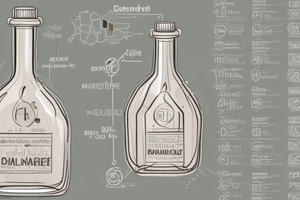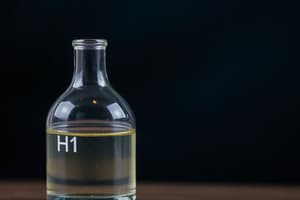Podcast
Questions and Answers
What are the three classes of compounds discussed in this unit?
What are the three classes of compounds discussed in this unit?
Alcohols, phenols, and ethers
What is the IUPAC system used for?
What is the IUPAC system used for?
Naming alcohols, phenols, and ethers
Which type of compounds are formed when hydrogen atoms in hydrocarbons are replaced by -OH groups?
Which type of compounds are formed when hydrogen atoms in hydrocarbons are replaced by -OH groups?
- Ethers
- Alcohols (correct)
- Aldehydes
- Esters
Phenols contain -OH groups attached to aliphatic carbon atoms.
Phenols contain -OH groups attached to aliphatic carbon atoms.
How are alcohols classified based on the number of hydroxyl groups?
How are alcohols classified based on the number of hydroxyl groups?
An alcohol contains one or more __________ group(s) directly attached to carbon atom(s).
An alcohol contains one or more __________ group(s) directly attached to carbon atom(s).
What is the structural formula for dimethyl ether?
What is the structural formula for dimethyl ether?
What are the three classes of compounds discussed in this unit?
What are the three classes of compounds discussed in this unit?
What does the substitution of a hydrogen atom in a hydrocarbon by –OH group produce?
What does the substitution of a hydrogen atom in a hydrocarbon by –OH group produce?
An alcohol contains one or more __________ group(s) directly attached to carbon atom(s).
An alcohol contains one or more __________ group(s) directly attached to carbon atom(s).
A phenol contains __________ group(s) directly attached to carbon atom(s) of an aromatic system.
A phenol contains __________ group(s) directly attached to carbon atom(s) of an aromatic system.
How can alcohols and phenols be classified based on hydroxyl group count?
How can alcohols and phenols be classified based on hydroxyl group count?
What is the general formula for a monohydric alcohol?
What is the general formula for a monohydric alcohol?
Ethers can be formed by substituting hydrogen atoms of hydroxyl groups of alcohols.
Ethers can be formed by substituting hydrogen atoms of hydroxyl groups of alcohols.
Flashcards are hidden until you start studying
Study Notes
Overview of Alcohols, Phenols, and Ethers
- Understanding IUPAC nomenclature is fundamental for naming alcohols, phenols, and ethers.
- These compounds serve as the foundation for producing detergents, antiseptics, and fragrances.
Formation and Reactions
- Alcohols can be synthesized from alkenes, aldehydes, ketones, and carboxylic acids.
- Phenols can be produced from haloarenes, benzene sulphonic acids, diazonium salts, and cumene.
- Ethers are formed through the substitution of hydrogen atoms in hydrocarbons with alkoxy or aryloxy groups.
Importance of Hydroxyl Groups
- Replacement of hydrogen in hydrocarbons by –OH results in new compounds (alcohols and phenols) with different properties and applications.
- Compounds containing hydroxyl groups, such as ethanol, are commonly used in everyday life, highlighting their significance.
Alcohols and Phenols
- Alcohols possess one or more hydroxyl (-OH) groups attached to carbon atoms in aliphatic systems (e.g., CH3OH).
- Phenols have –OH groups linked to carbon atoms in aromatic systems (e.g., C6H5OH).
- Ethers are formed by substituting a hydrogen atom of a hydroxyl group in alcohols or phenols with an alkyl or aryl group (e.g., dimethyl ether, CH3OCH3).
Classification of Alcohols and Phenols
- Compounds are classified into mono-, di-, tri-, or polyhydric alcohols based on the number of hydroxyl groups they contain.
- Alcohols can be categorized further based on the carbon hybridization of the carbon atom bonded to the hydroxyl group, particularly distinguishing the Csp3−OH bond.
Practical Applications
- Alcohols, phenols, and ethers have extensive uses in various industries.
- Common items like spirit for polishing furniture, sugars, cotton, and paper are comprised of compounds that include hydroxyl groups.
Summary of Hydroxyl Compounds
- Hydroxyl groups are crucial for the formation and diversity of alcohols and phenols, influencing their physical and chemical properties.
- The systematic classification of these compounds aids in better understanding and utilization in chemical applications.
Overview of Alcohols, Phenols, and Ethers
- Understanding IUPAC nomenclature is fundamental for naming alcohols, phenols, and ethers.
- These compounds serve as the foundation for producing detergents, antiseptics, and fragrances.
Formation and Reactions
- Alcohols can be synthesized from alkenes, aldehydes, ketones, and carboxylic acids.
- Phenols can be produced from haloarenes, benzene sulphonic acids, diazonium salts, and cumene.
- Ethers are formed through the substitution of hydrogen atoms in hydrocarbons with alkoxy or aryloxy groups.
Importance of Hydroxyl Groups
- Replacement of hydrogen in hydrocarbons by –OH results in new compounds (alcohols and phenols) with different properties and applications.
- Compounds containing hydroxyl groups, such as ethanol, are commonly used in everyday life, highlighting their significance.
Alcohols and Phenols
- Alcohols possess one or more hydroxyl (-OH) groups attached to carbon atoms in aliphatic systems (e.g., CH3OH).
- Phenols have –OH groups linked to carbon atoms in aromatic systems (e.g., C6H5OH).
- Ethers are formed by substituting a hydrogen atom of a hydroxyl group in alcohols or phenols with an alkyl or aryl group (e.g., dimethyl ether, CH3OCH3).
Classification of Alcohols and Phenols
- Compounds are classified into mono-, di-, tri-, or polyhydric alcohols based on the number of hydroxyl groups they contain.
- Alcohols can be categorized further based on the carbon hybridization of the carbon atom bonded to the hydroxyl group, particularly distinguishing the Csp3−OH bond.
Practical Applications
- Alcohols, phenols, and ethers have extensive uses in various industries.
- Common items like spirit for polishing furniture, sugars, cotton, and paper are comprised of compounds that include hydroxyl groups.
Summary of Hydroxyl Compounds
- Hydroxyl groups are crucial for the formation and diversity of alcohols and phenols, influencing their physical and chemical properties.
- The systematic classification of these compounds aids in better understanding and utilization in chemical applications.
Studying That Suits You
Use AI to generate personalized quizzes and flashcards to suit your learning preferences.




